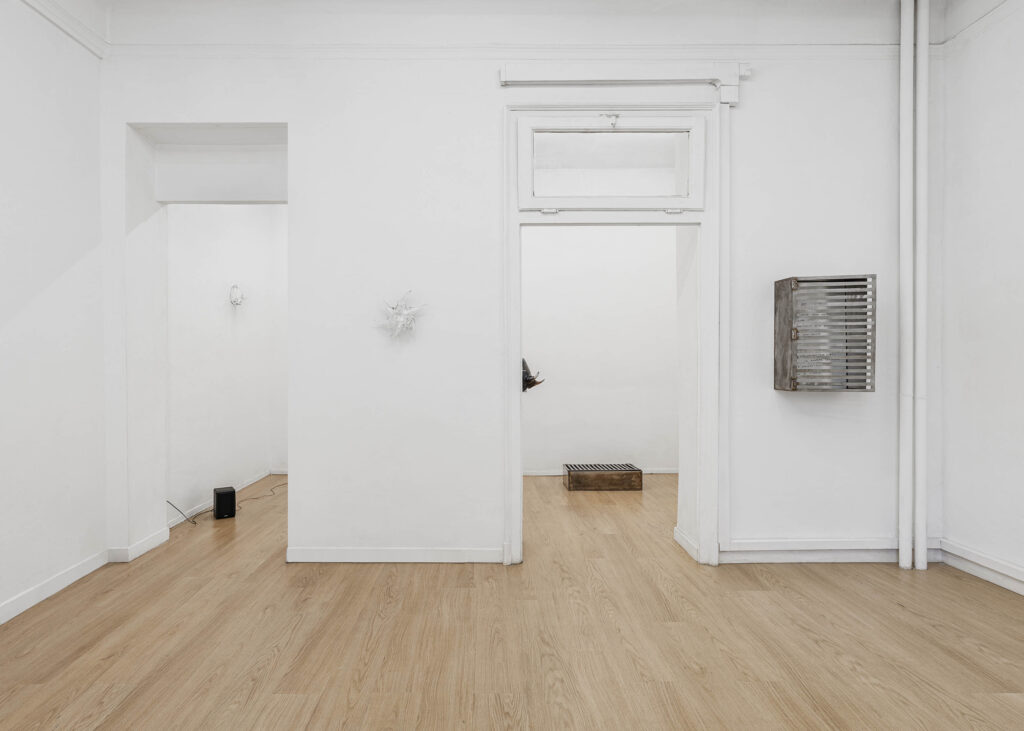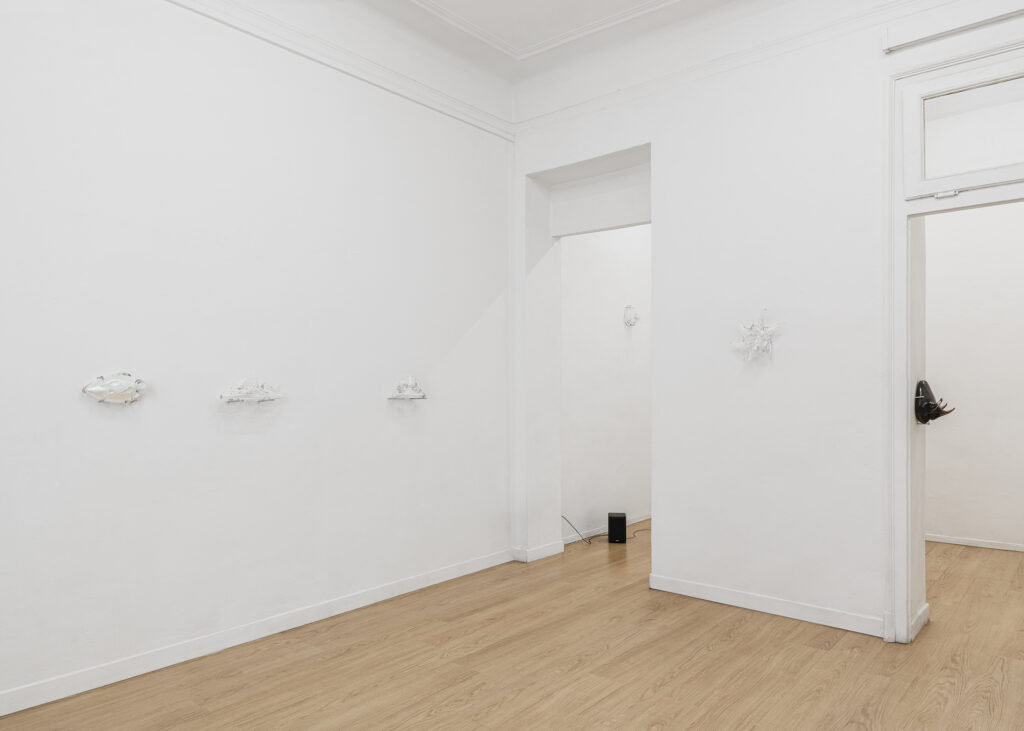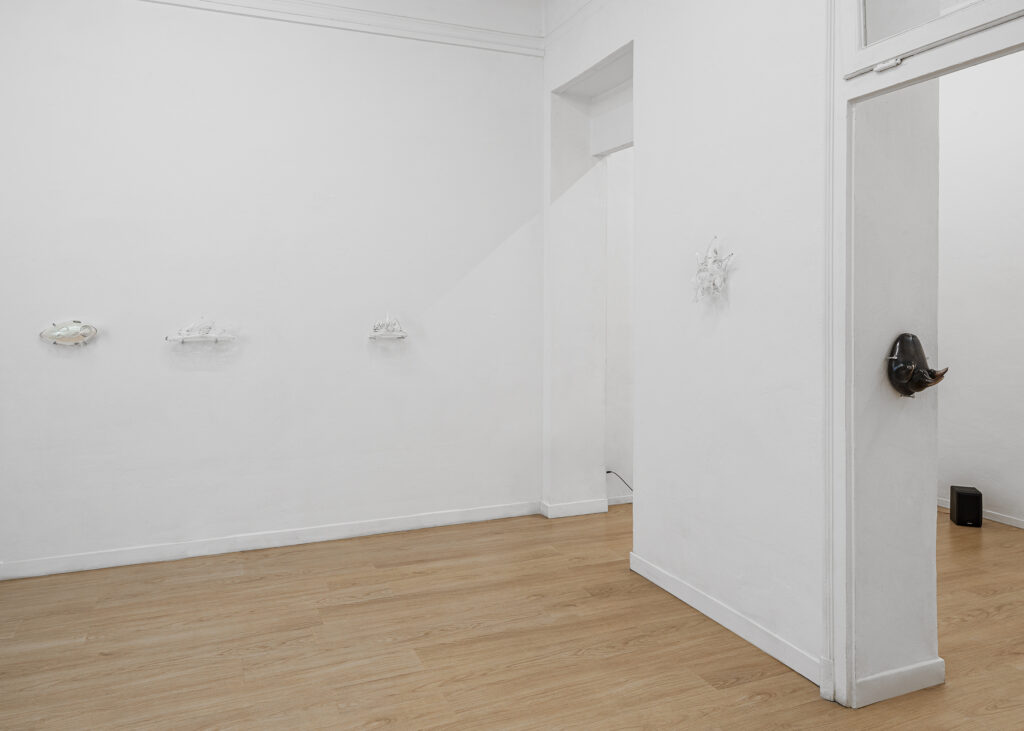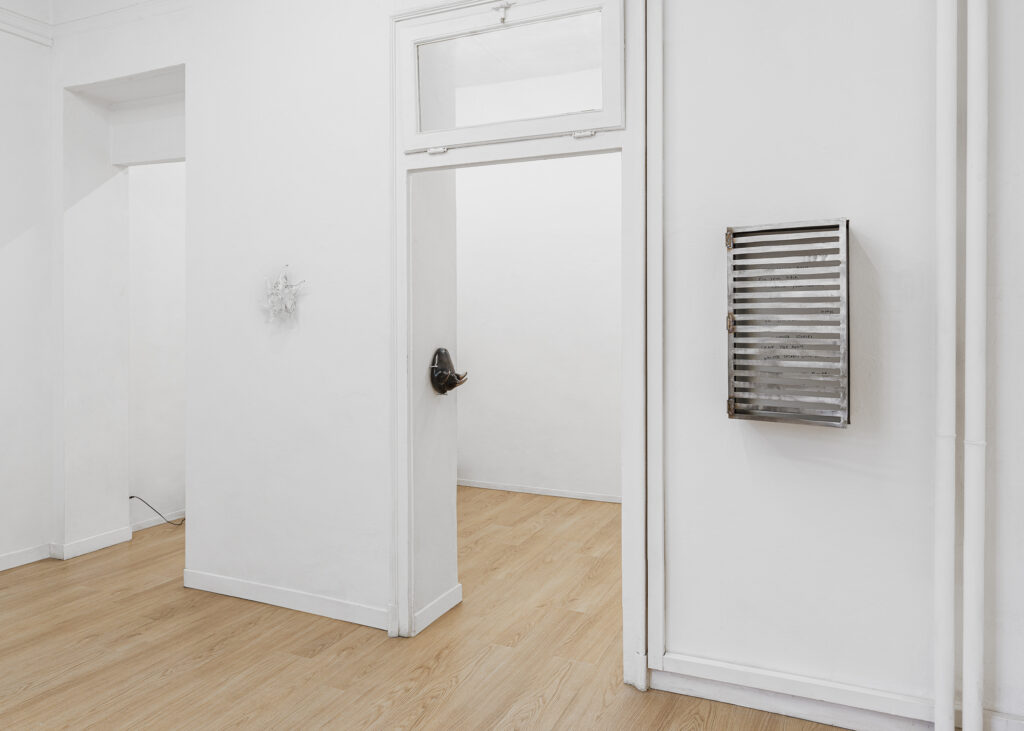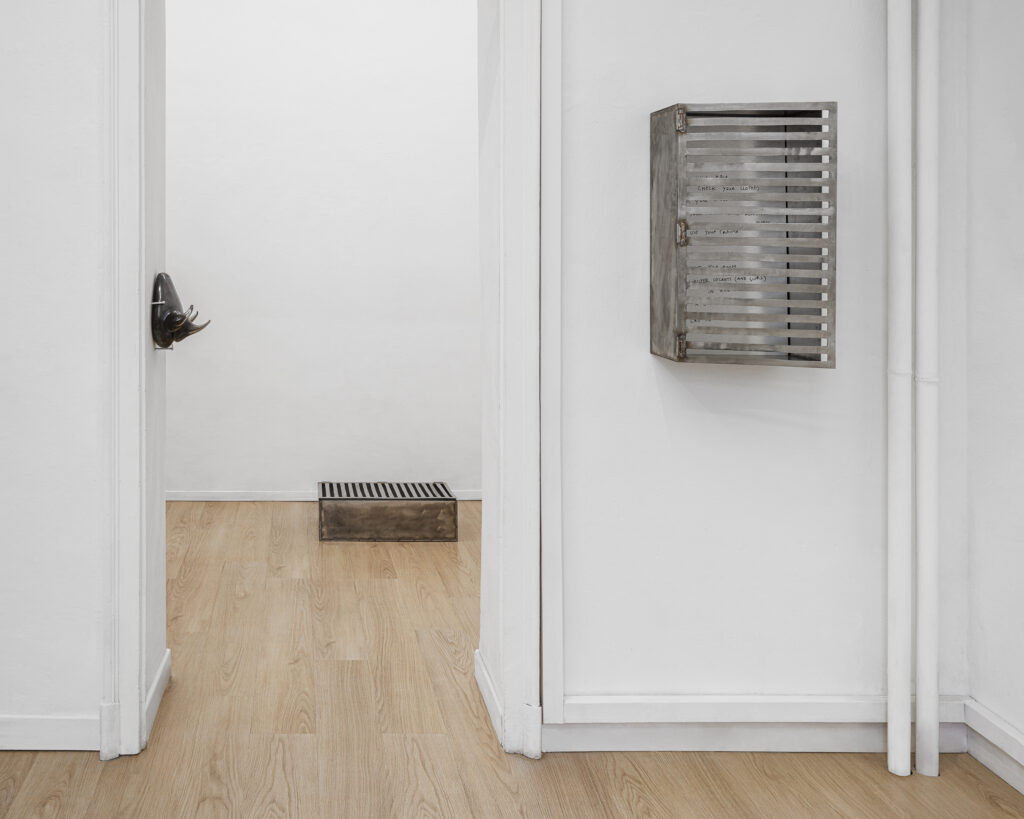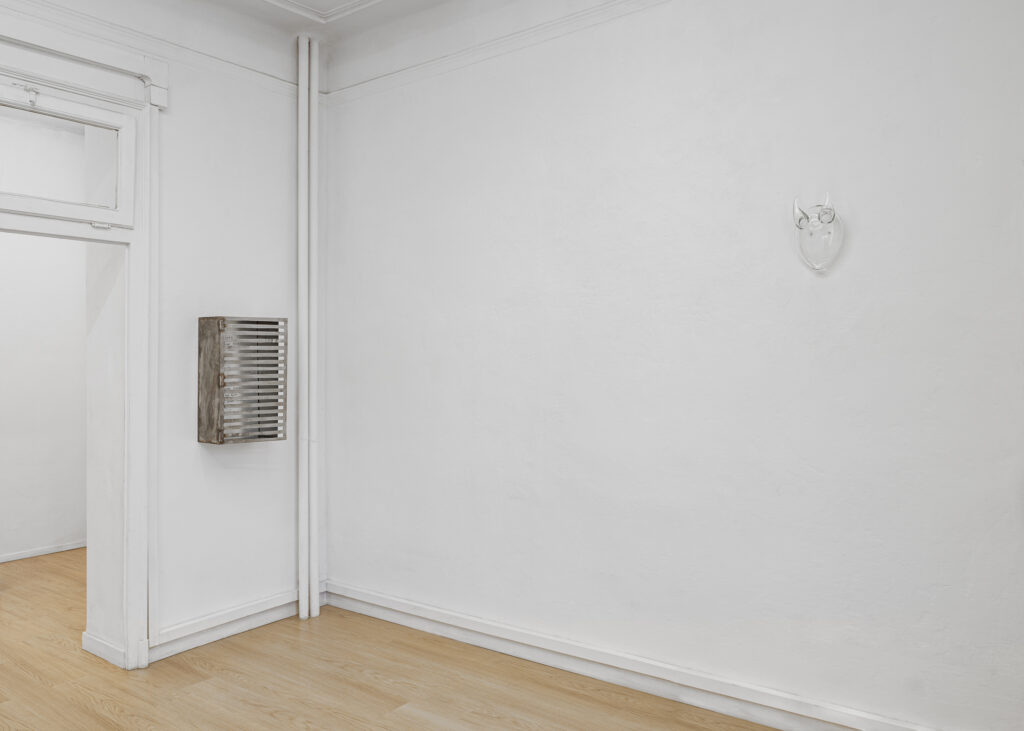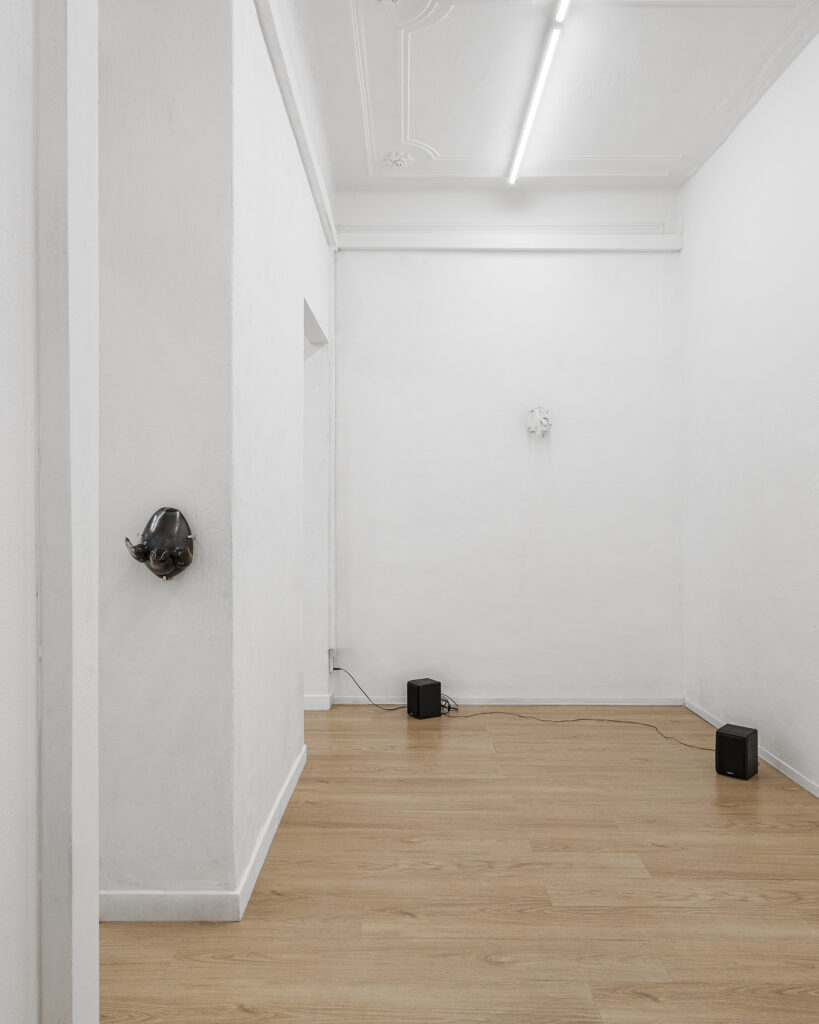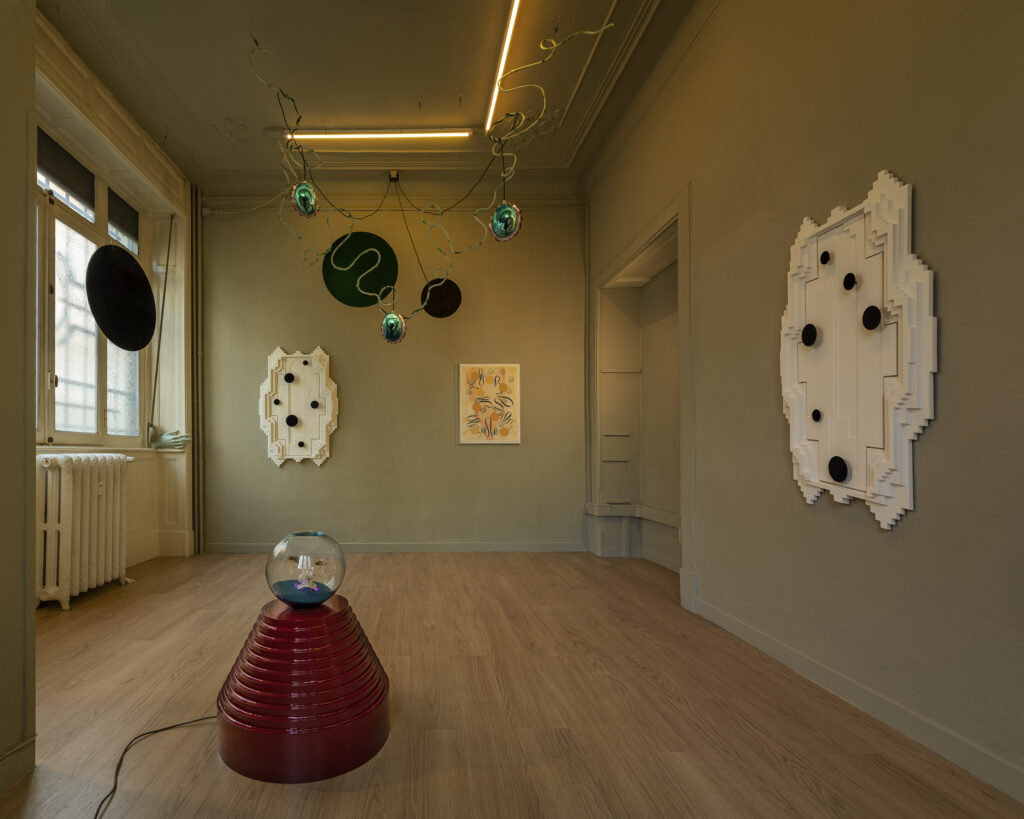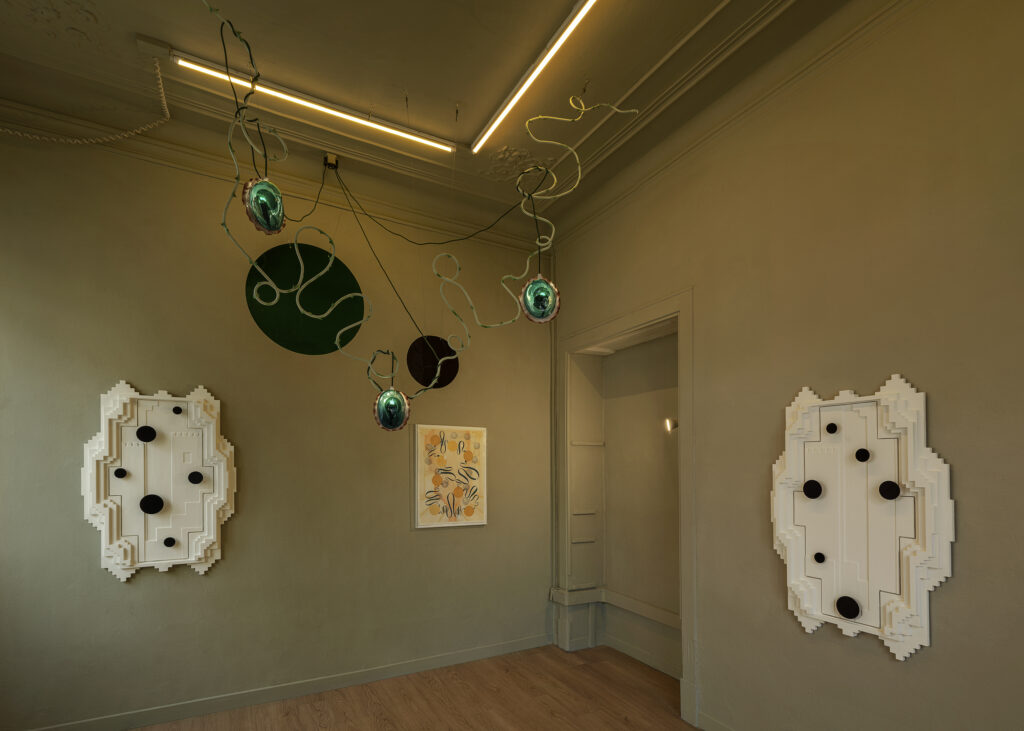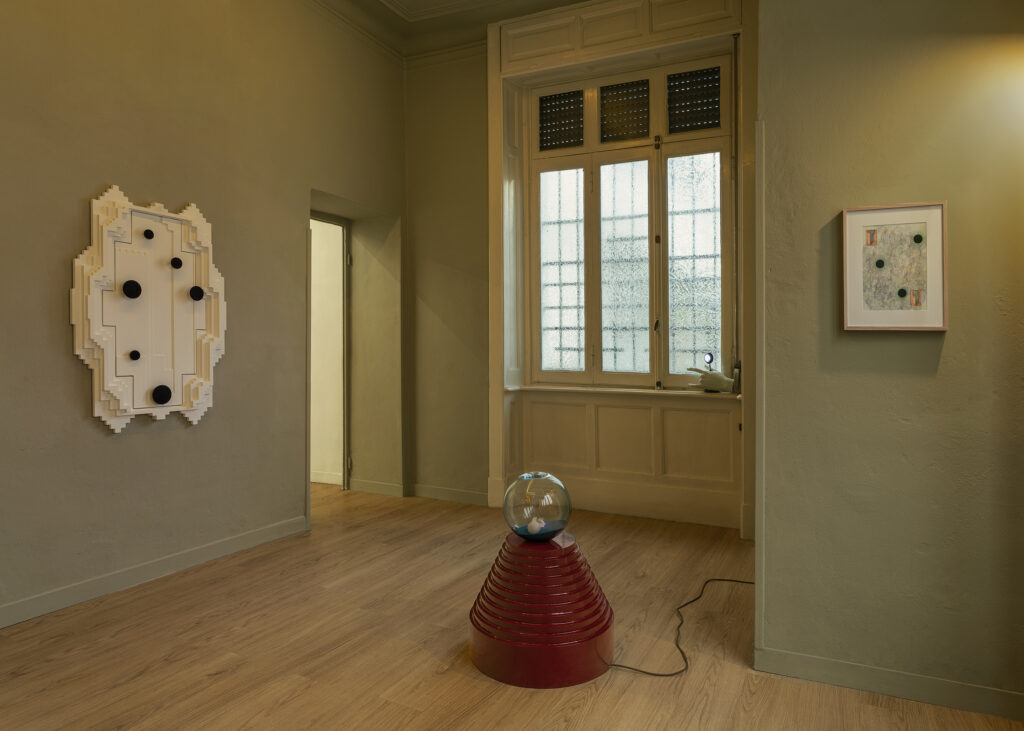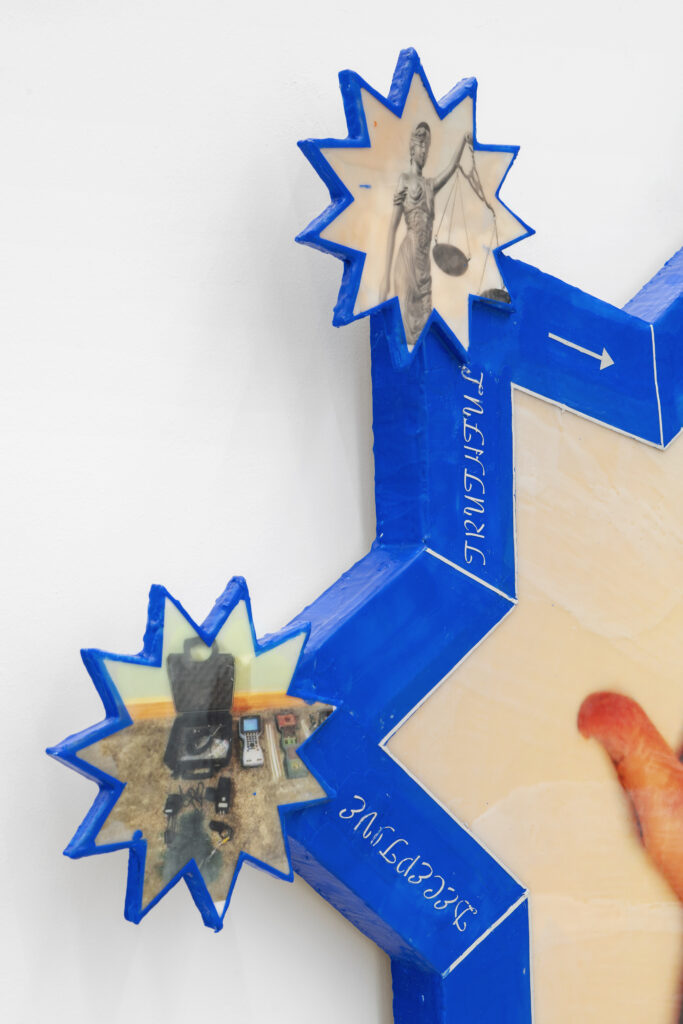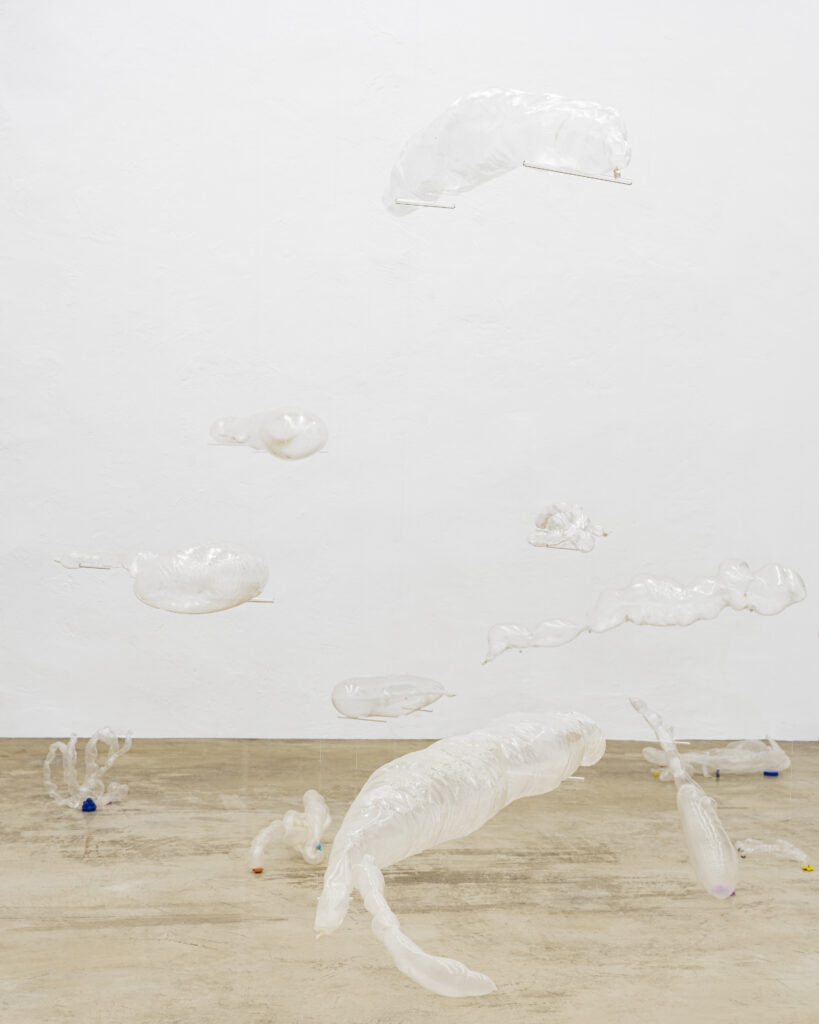you can now enter: notes on immersion
Tarek Lakhrissi and Tai Shani
curated by Giulia Civardi
opening reception 15.03.2023
16.03.2023 – 07.05.2023
All photo: Flavio Pescatori
Immersion is often viewed as a one-off event: a highly engaging ‘experience’, a deep mental involvement or flow that transports us to another layer of reality. Yet, in many ways, immersion is less about the simple ‘act’ of dipping into a substance or a state – rather, it invokes a complete lack of a material distinction between all beings and the world. It is about continuous access without drowning, a practice of presence. This view of immersion or ‘exercise’ is helpful when certain spaces are accessible for some and impenetrable for others. When access is not granted or authorised, but it is struggled for and must be imagined.
Within the gallery space, Tarek Lakhrissi and Tai Shani’s work challenges notions of access on a material and perceptive level. Both artists seek collectivity and share a sensibility towards affect, hybridity, marginal narratives and poetic gestures that circumvent restrictive language structures. Their work, presented for the first time in Milan, take cues from both Italian subaltern histories and revised canonical narratives, opening the doors to other social worlds while remaining grounded in the current one.
II. [crossing]
In his newly-commissi (...)
you can now enter: notes on immersion
Tarek Lakhrissi and Tai Shani
curated by Giulia Civardi
opening reception 15.03.2023
16.03.2023 – 07.05.2023
All photo: Flavio Pescatori
Immersion is often viewed as a one-off event: a highly engaging ‘experience’, a deep mental involvement or flow that transports us to another layer of reality. Yet, in many ways, immersion is less about the simple ‘act’ of dipping into a substance or a state – rather, it invokes a complete lack of a material distinction between all beings and the world. It is about continuous access without drowning, a practice of presence. This view of immersion or ‘exercise’ is helpful when certain spaces are accessible for some and impenetrable for others. When access is not granted or authorised, but it is struggled for and must be imagined.
Within the gallery space, Tarek Lakhrissi and Tai Shani’s work challenges notions of access on a material and perceptive level. Both artists seek collectivity and share a sensibility towards affect, hybridity, marginal narratives and poetic gestures that circumvent restrictive language structures. Their work, presented for the first time in Milan, take cues from both Italian subaltern histories and revised canonical narratives, opening the doors to other social worlds while remaining grounded in the current one.
II. [crossing]
In his newly-commissioned body of work, a multi-sensory installation encompassing text, sound, and sculpture, Tarek Lakhrissi investigates means of entry, re-imagining constraining spaces by conjuring the metaphysical space of ‘hell’. Drawing from his background in literature, Lakhrissi delves into a revised version of Dante’s Inferno, considering Monique Wittig’s lesbian re-writing of the same. In Wittig’s experimental narration, ‘l’enfer’ is a place with rigid conditions, both social and climatic. But unlike Dante’s story, hell is often more common-looking than it seems: it’s accessed via a bar or a pool club, and it’s a place or a situation where Wittig is faced with difficult decisions that put into question her choices in a normative world. Lakhrissi’s work embraces the queer tools embedded in Wittig’s quest, making space for transformative narratives. If ‘hell’ is a place where undesirables are relegated, then Lakhrissi makes it hospitable for all those who are ‘other’. Together with composer Victor Da Silva, he combines sonic traces partly inspired by the Cloud Rap music of TRIPLEGO into an atmospheric sound piece that suspends time and creates a space in between a club and an eerie otherwordly dimension. For Lakhrissi, grates – a recurring visual element found in the streets of Milan – become portals and access points. A poem is embedded in one of the metal sculptures, inviting the reader to find a garden, a space to be with one’s feelings and personal struggles. Inside another grate are little devil creatures
– hybrid beings that are both dangerous and faithful guides. Small fires, with their transparency and aqua-coloured iridescence, seem more playful than harmful. The materiality of glass, metal, words and sounds opens an emotional space to re-engage with physicality. By carefully crafting objects and traditions, Lakhrissi creates a place for otherness, a suspension of ‘good’ and ‘evil’: an intimate threshold for sharing and community.
Meanwhile, in Tai Shani’s sculptures and paintings spatial and temporal perspectives merge and flip. Floating bas-reliefs reveal towers, merlons, and stairways from multiple vantage points, their labyrinthine architecture collapsing above and below into one. These map-like relics, recalling both mediaeval buildings and sleek spaceships alike, seem to emerge from an ancient future and elude linear time. Their spheres and staircases repeat on the multi-dimensional, translucent surface of paintings, which the artist began making during lockdown. “These look like and are portals for me to enter into a connected space”, writes Shani, referring to these paintings as intimate interior spaces freed from “the patriarchal language and structures that restrict lives and imaginations”. In the sculptures, references to vegetal and supernatural figures, become conduits to revise these structures and political histories. A dome on a pyramidal pedestal contains the body part of a witch or a Maiara, a rare example of a benevolent witch in European history that was seen on the island of Alicudi during various instances of Ergot consumption. The witch is not only a figure that stands at the threshold between human and fantasy, a wrecker of morality and civilisation. But also a label that was often attributed to older women, who had limited resources and access to survival. When ergot – a fungus that grows on grains from which LSD is derived – contaminated the rye used to mill bread, the inhabitants of the island of Alicudi found themselves experiencing episodes of visions and hallucinations. In the 450 years of contamination, legends spread of women flying to the mainland in Palermo or Calabria and returning with bags full of food. Shani’s work revives the mythologies and the psychedelic histories of the Aeolian islands, which speak of food scarcity due to land enclosures, exposing material interconnections and realist fantasies against oppressive systems. Like in the popular genre of botanical gothic fiction, vegetal figures transition from a romantic natural backdrop to supernatural actors. Spores and vines become protagonists. The golden rye in a globe temple, a vine with glass eyes hanging from the ceiling, and spiralling ribbons in the painting all become a thread connecting the black sporal dots to access a state of connection and interdependence with all things: an urge towards the collective.
III. [immerse]
Philosopher Emanuele Coccia argues that plants are a “paradigm of immersion” in that they have “contiguity” with their environments: they draw nutrients from the soil and produce the environmental conditions for all life to rot and re-grow. They are physically enmeshed in a world that accommodates them, able to fundamentally shape the world and themselves. It is this continuous and constant co-penetration, the reciprocal ‘mix without losing their identity’ and active exchange that nurtures coexistence.
In this materialist vein, every being is capable of ‘accessing’ and radically transforming the world. Rather than provoking isolated experiences, these works offer subtle reorganisations of the senses.
By redefining perception, and exposing the relationships and boundaries between subjects, substances, systems, and worlds, we perform this ongoing immersive act. You might need to find a way to ‘enter’, feel yourself, and adjust, but you are already here.
text by Giulia Civardi
You can now enter
The bright room
Fix your hair
Check your clothes
Kiss your bones
Use your mouth
With beautiful words
Use your trauma
Make it fashionable
Tell whatever stories
Leave the room
Whisper secrets in another language
Find a garden with flowers
Cry in silence.
— Tarek Lakhrissi
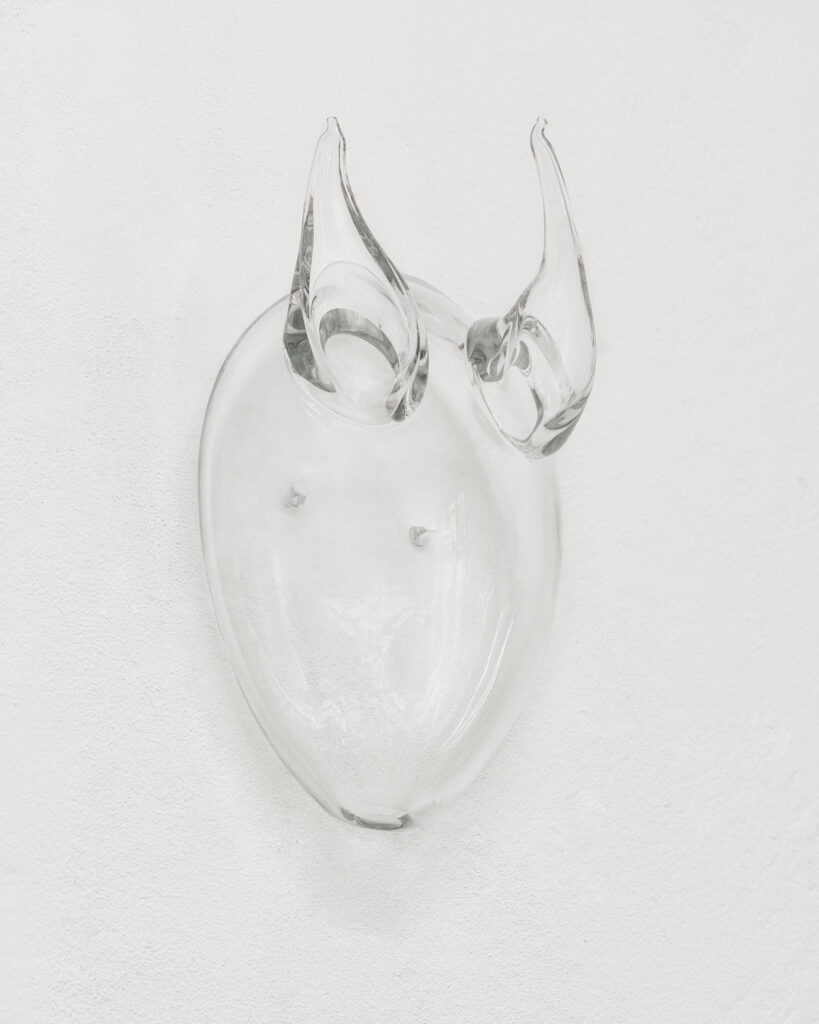 Tarek Lakhrissi...HURTS ME SO BAD I LOVE IT, 2023
Tarek Lakhrissi...HURTS ME SO BAD I LOVE IT, 2023
Blown glass
33x20x11 cm
Courtesy: The Artist, Clima, Milan and Galerie Allen,Paris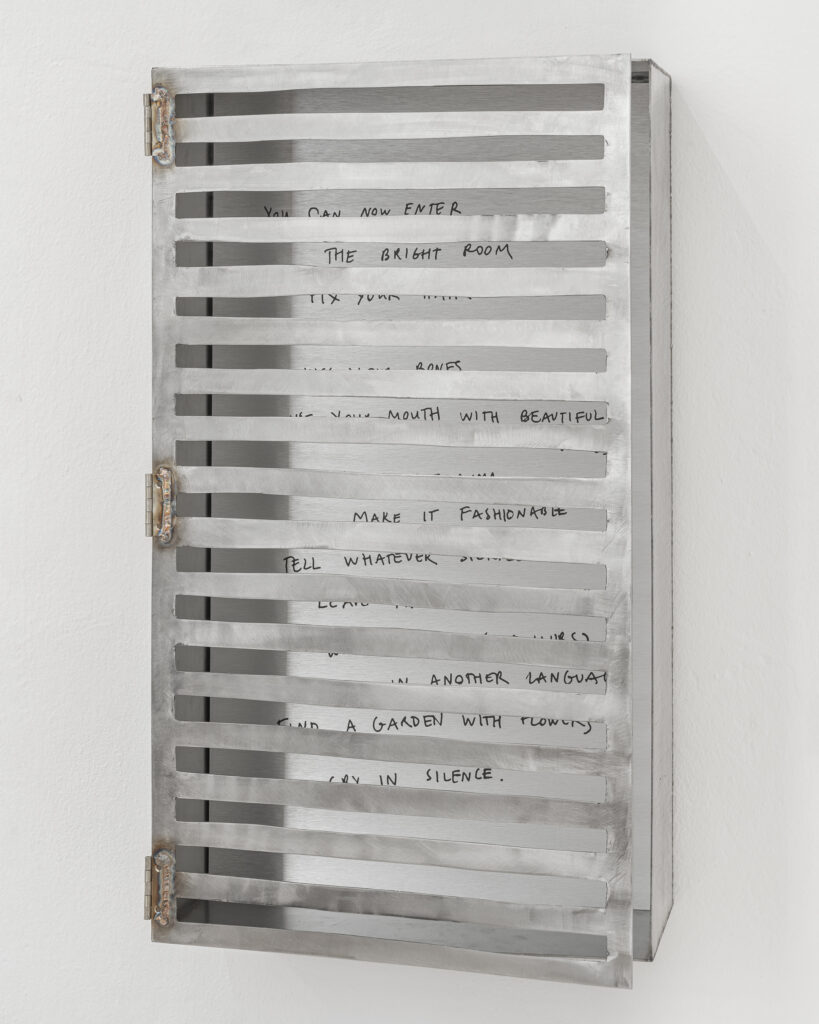 Tarek LakhrissiCOME TO ME, 2023
Tarek LakhrissiCOME TO ME, 2023
Stainless steel, aluminium plate
70x40x20 cm
Courtesy: The Artist, Clima, Milan and Galerie Allen,Paris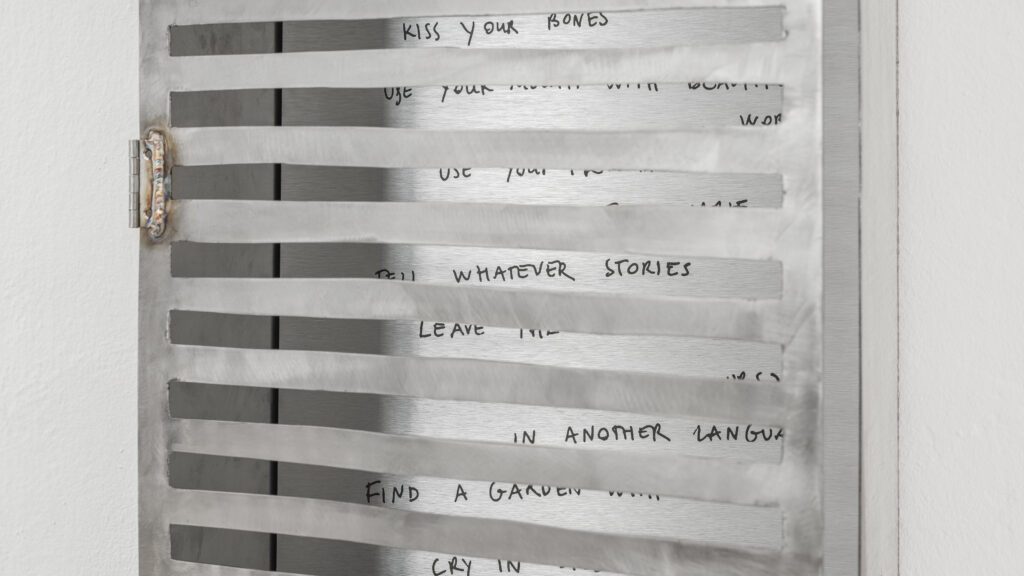 Tarek LakhrissiCOME TO ME, 2023 (Detail)
Tarek LakhrissiCOME TO ME, 2023 (Detail)
Stainless steel, aluminium plate
70x40x20 cm
Courtesy: The Artist, Clima, Milan and Galerie Allen,Paris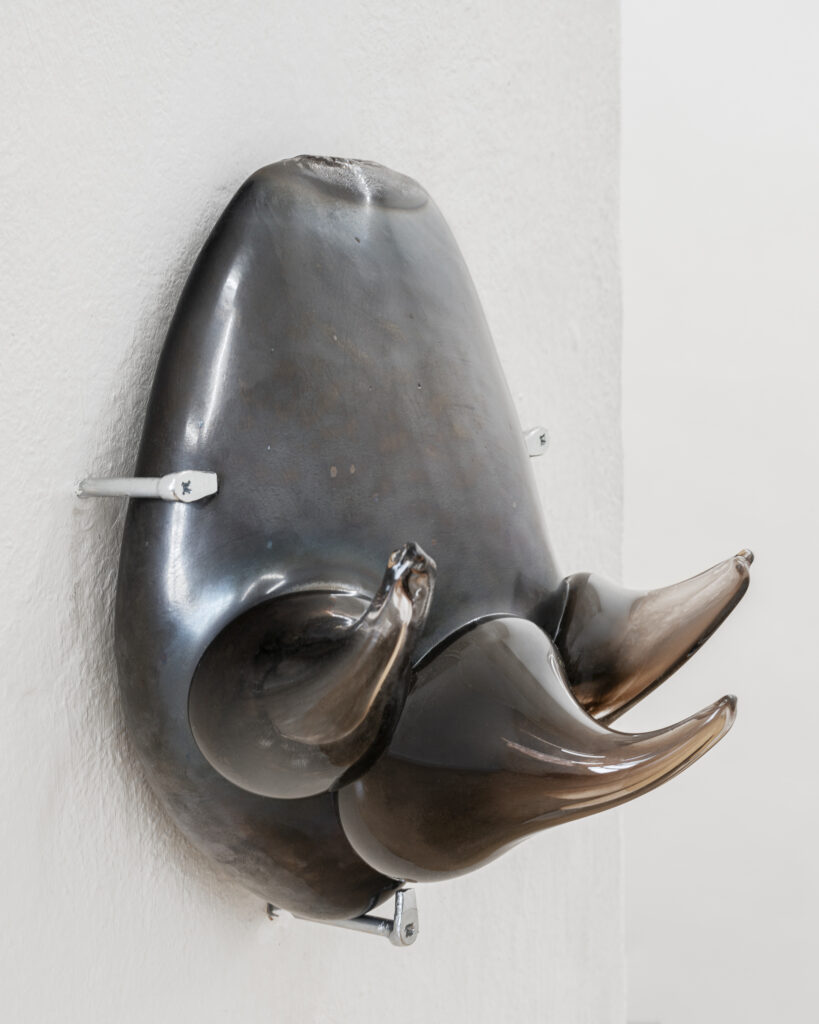 Tarek LakhrissiBABY BOWSER, 2023
Tarek LakhrissiBABY BOWSER, 2023
Blown glass
21x19x17 cm
Courtesy: The Artist, Clima, Milan and Galerie Allen,Paris Tarek LakhrissiBABY BOWSER, 2023
Tarek LakhrissiBABY BOWSER, 2023
Blown glass
21x19x17 cm
Courtesy: The Artist, Clima, Milan and Galerie Allen,Paris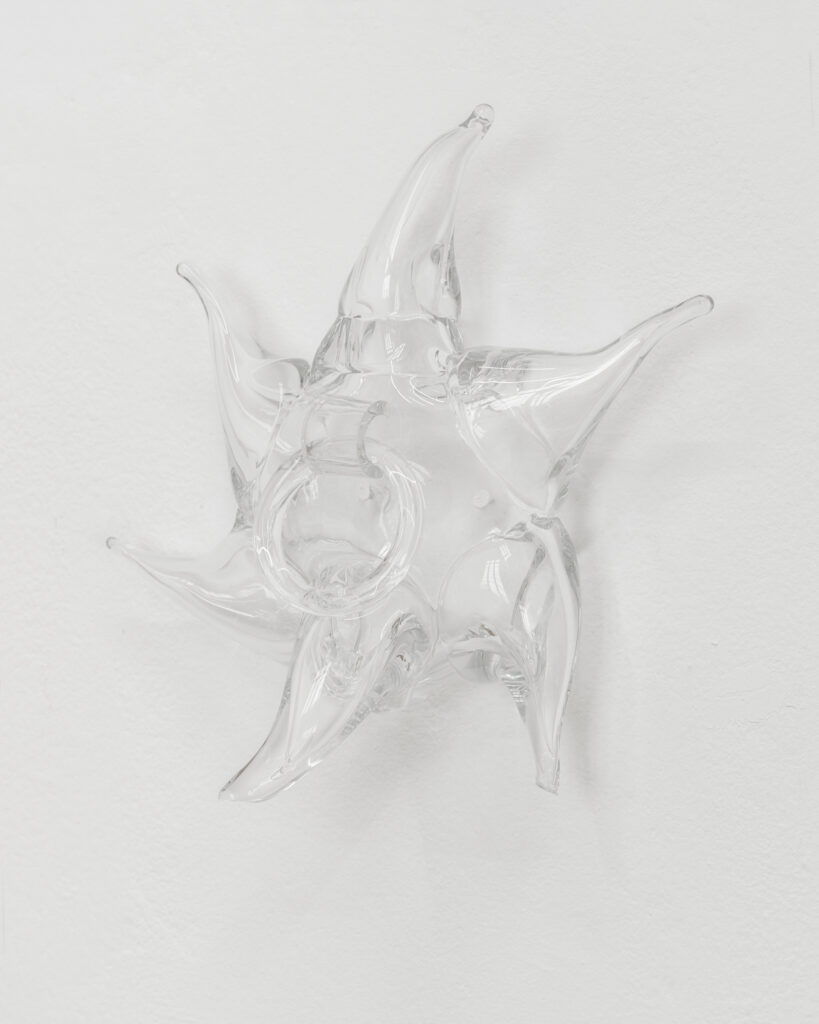 Tarek LakhrissiUNSEEN SUN, 2023
Tarek LakhrissiUNSEEN SUN, 2023
Blown glass
32x26x12 cm
Courtesy: The Artist, Clima, Milan and Galerie Allen,Paris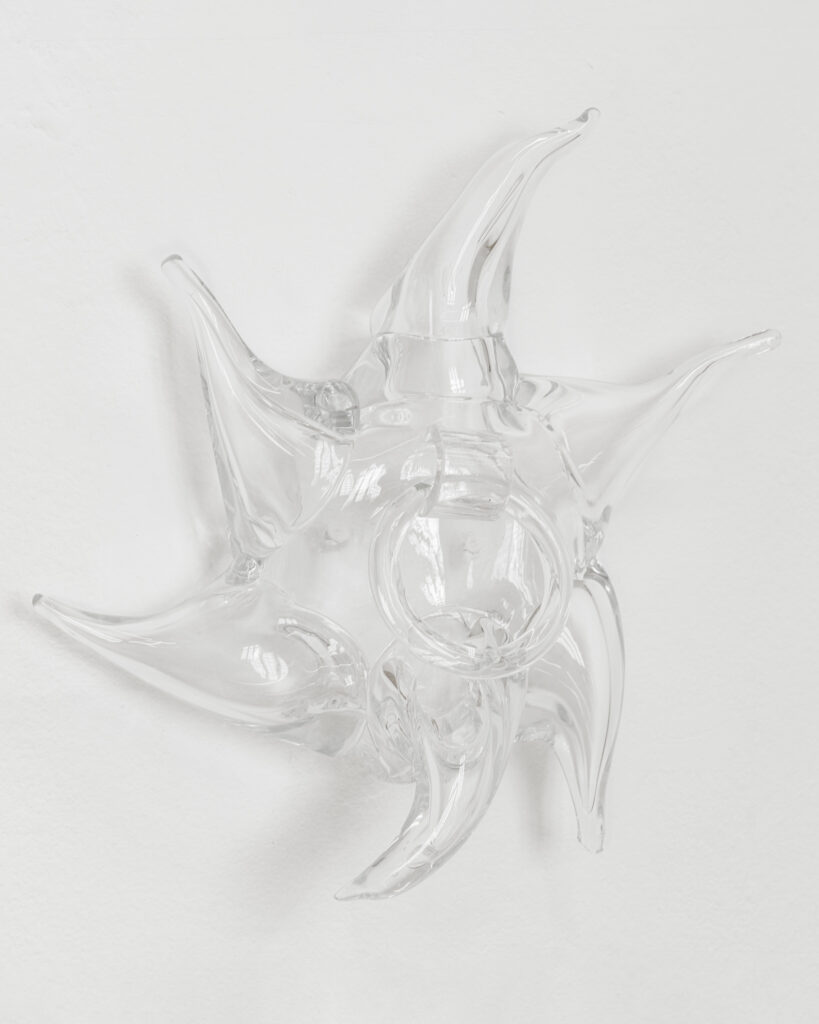 Tarek LakhrissiUNSEEN SUN, 2023
Tarek LakhrissiUNSEEN SUN, 2023
Blown glass
32x26x12 cm
Courtesy: The Artist, Clima, Milan and Galerie Allen,Paris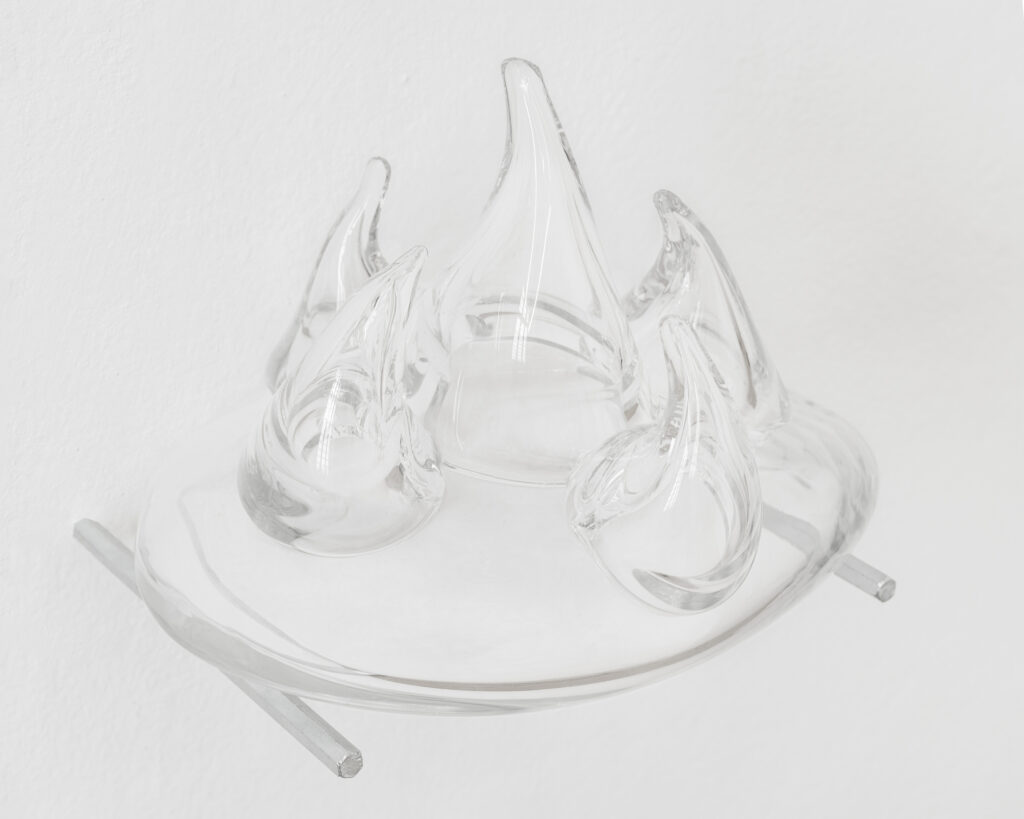 Tarek LakhrissiTENEBRAE, 2023
Tarek LakhrissiTENEBRAE, 2023
Blown glass
30x20x19 cm
Courtesy: The Artist, Clima, Milan and Galerie Allen,Paris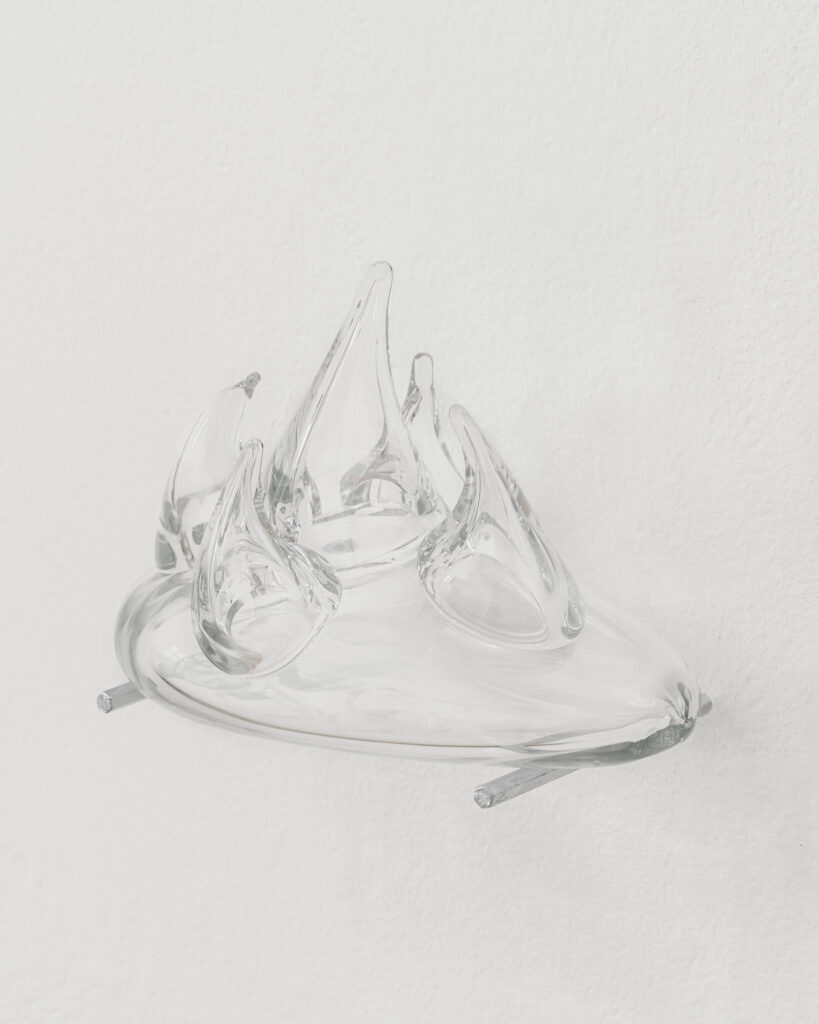 Tarek LakhrissiTENEBRAE, 2023
Tarek LakhrissiTENEBRAE, 2023
Blown glass
30x20x19 cm
Courtesy: The Artist, Clima, Milan and Galerie Allen,Paris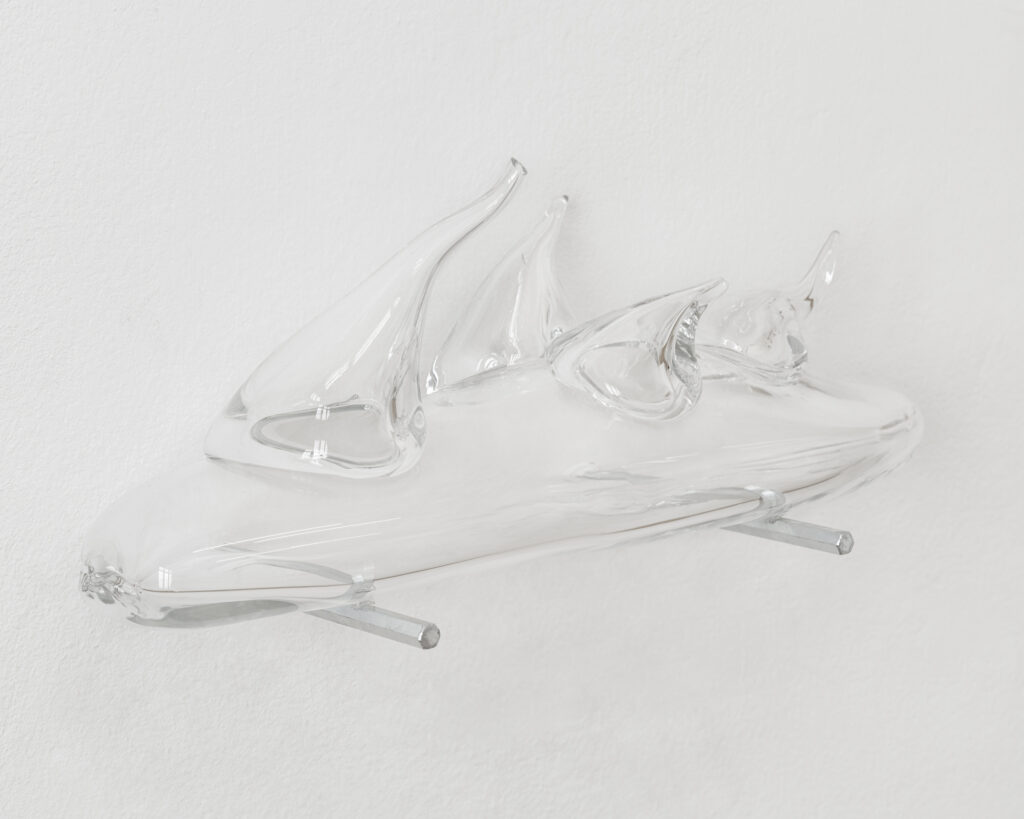 Tarek LakhrissiMOTHER OF DRAGONS, 2023
Tarek LakhrissiMOTHER OF DRAGONS, 2023
Blown glass
39x16x14 cm
Courtesy: The Artist, Clima, Milan and Galerie Allen,Paris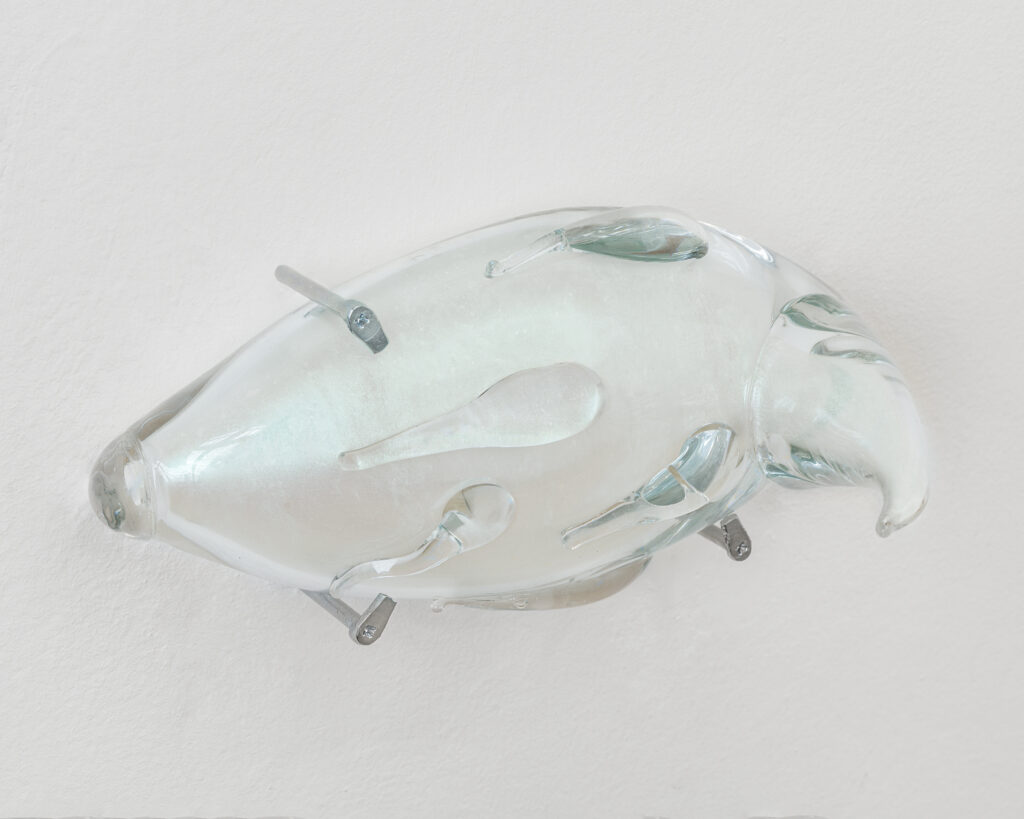 Tarek LakhrissiIRIDESCENT TEAR, 2023
Tarek LakhrissiIRIDESCENT TEAR, 2023
Blown glass
14x17x17 cm
Courtesy: The Artist, Clima, Milan and Galerie Allen,Paris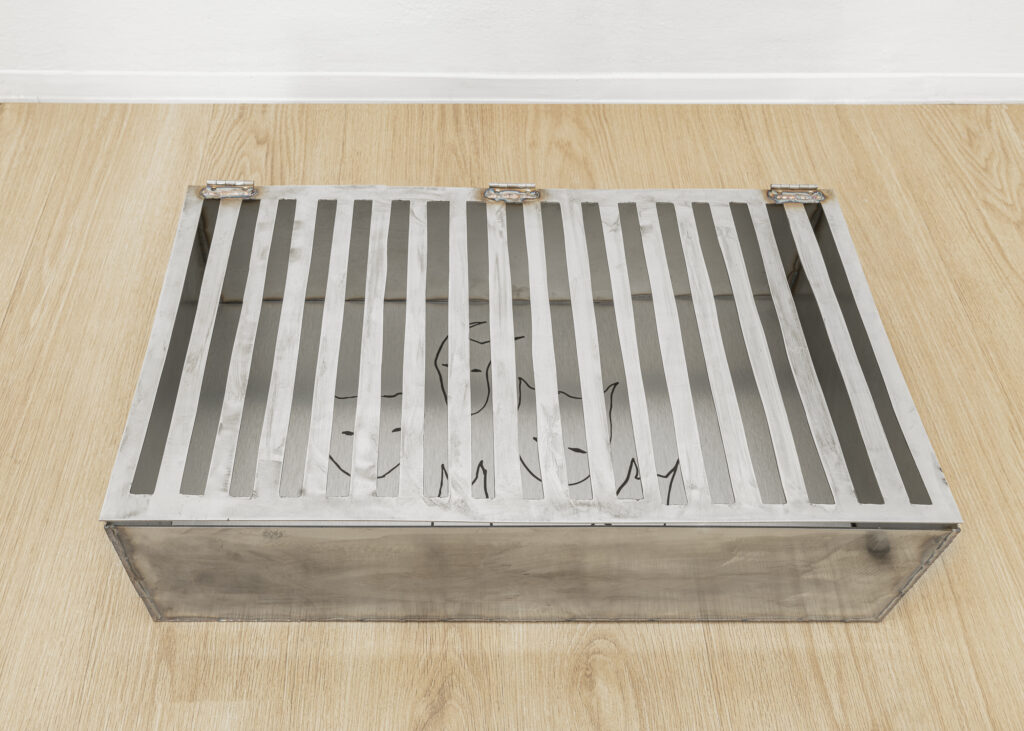 Tarek LakhrissiGTFOH, 2023
Tarek LakhrissiGTFOH, 2023
Stainless steel, aluminium plate
70x40x20 cm
Courtesy: The Artist, Clima, Milan and Galerie Allen,Paris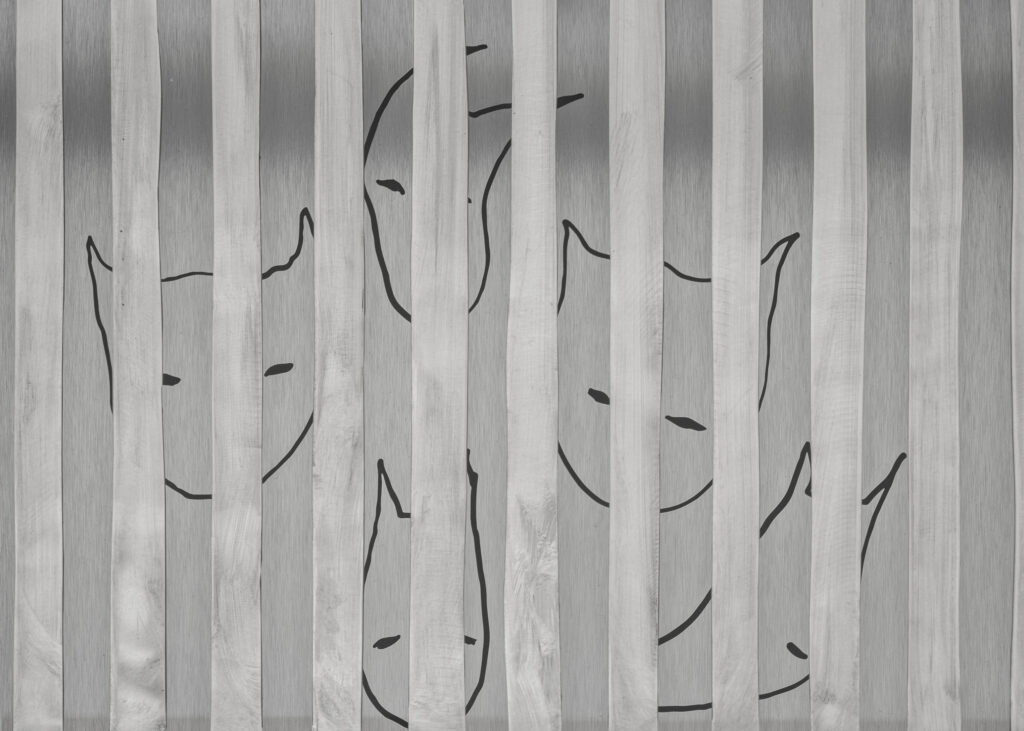 Tarek LakhrissiGTFOH, 2023 (Detail)
Tarek LakhrissiGTFOH, 2023 (Detail)
Stainless steel, aluminium plate
70x40x20 cm
Courtesy: The Artist, Clima, Milan and Galerie Allen,Paris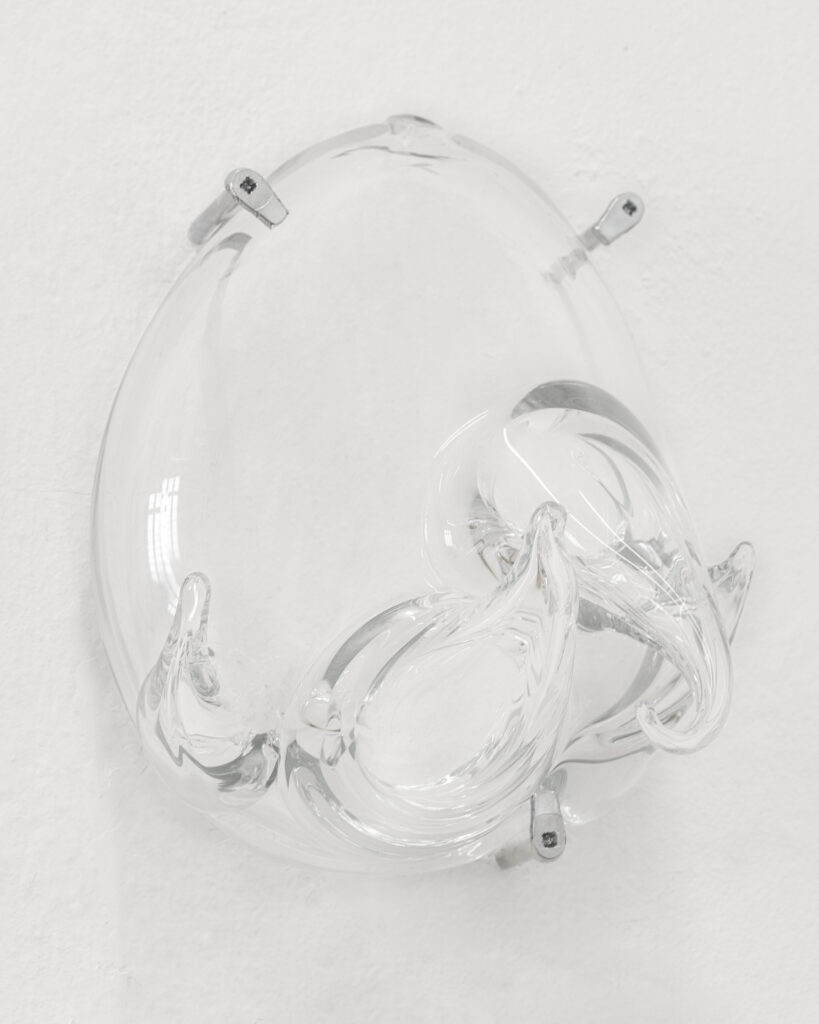 Tarek LakhrissiNEST, FEU, ETC., 2023
Tarek LakhrissiNEST, FEU, ETC., 2023
Blown glass
33x20x11 cm
Courtesy: The Artist, Clima, Milan and Galerie Allen,Paris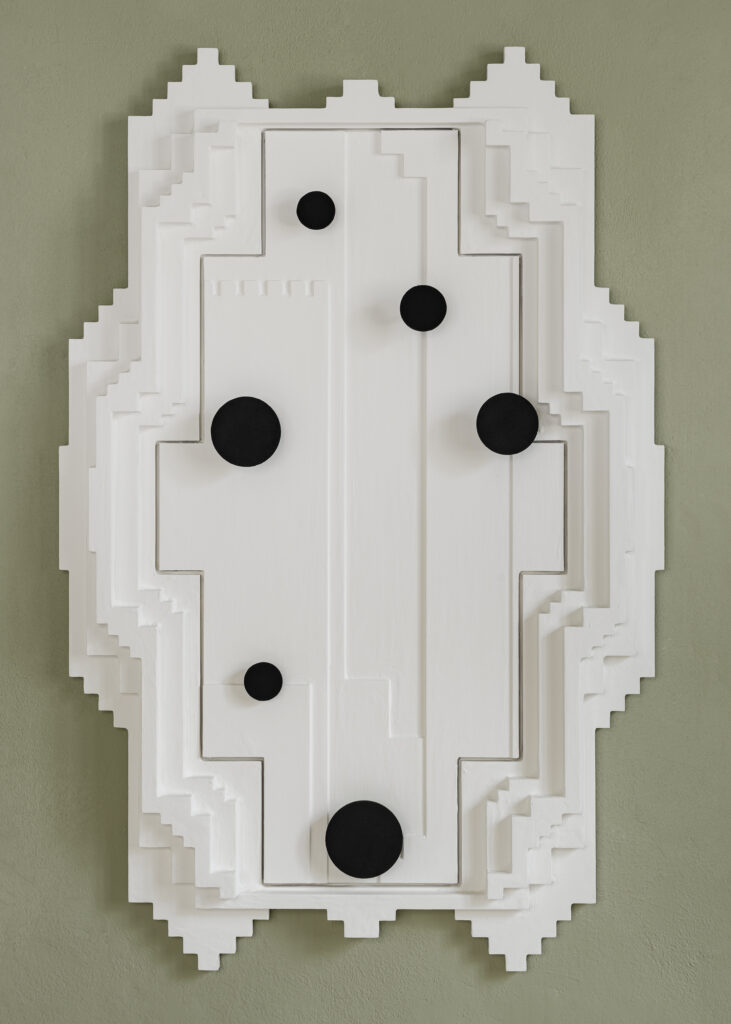 Tai ShaniThe Neon Hieroglyph: Astrolatrous Communes, 2022
Tai ShaniThe Neon Hieroglyph: Astrolatrous Communes, 2022
Bas relief: MDF, Jesmonite, flock, paint
80x120x6 cm
Courtesy: The Artist, Clima, Milan and Gathering,London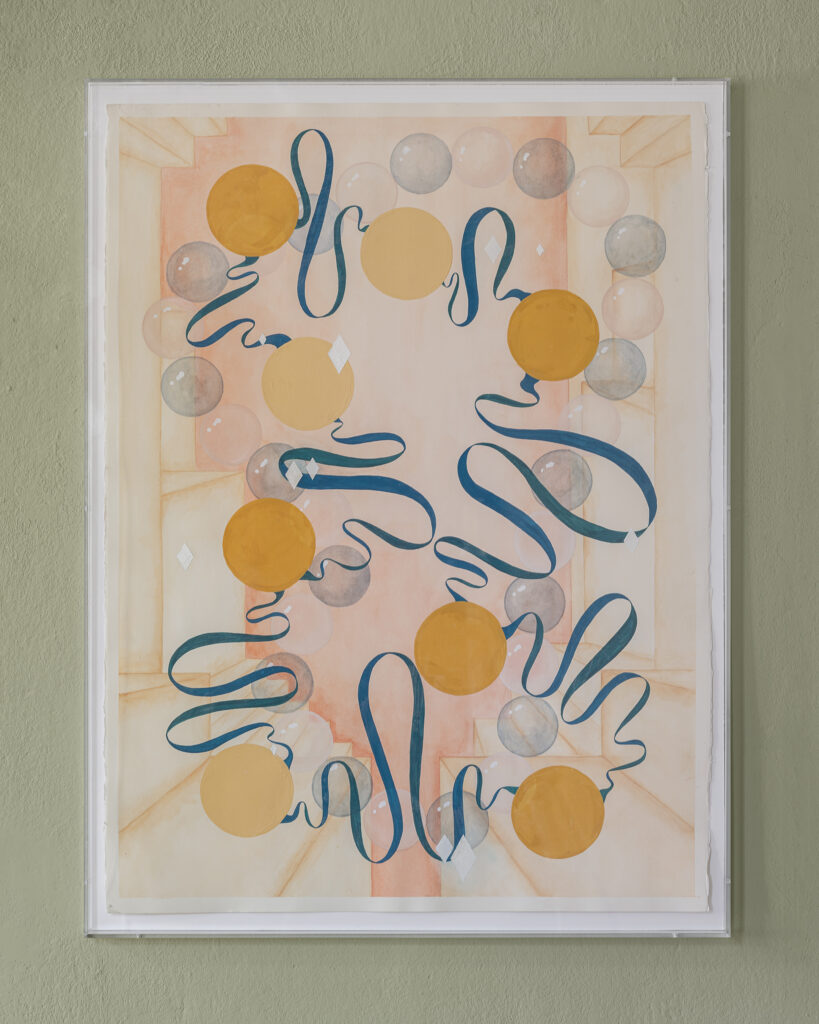 Tai ShaniOutsides & Erotics (Orange), 2021
Tai ShaniOutsides & Erotics (Orange), 2021
Watercolor on paper
56x76 cm (60 x 80 cm framed)
Courtesy: The Artist and Clima,Milan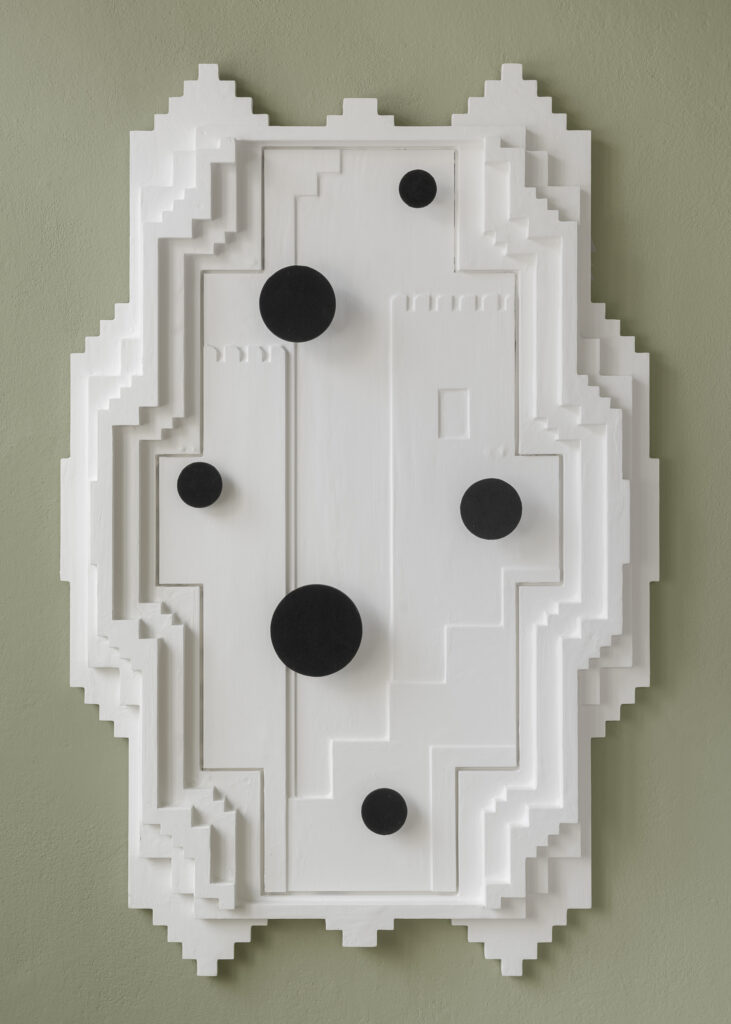 Tai ShaniThe Neon Hieroglyph: Astrolatrous Communes, 2022
Tai ShaniThe Neon Hieroglyph: Astrolatrous Communes, 2022
Bas relief: MDF, Jesmonite, flock, paint
80x120x6 cm
Courtesy: The Artist, Clima, Milan and Gathering,London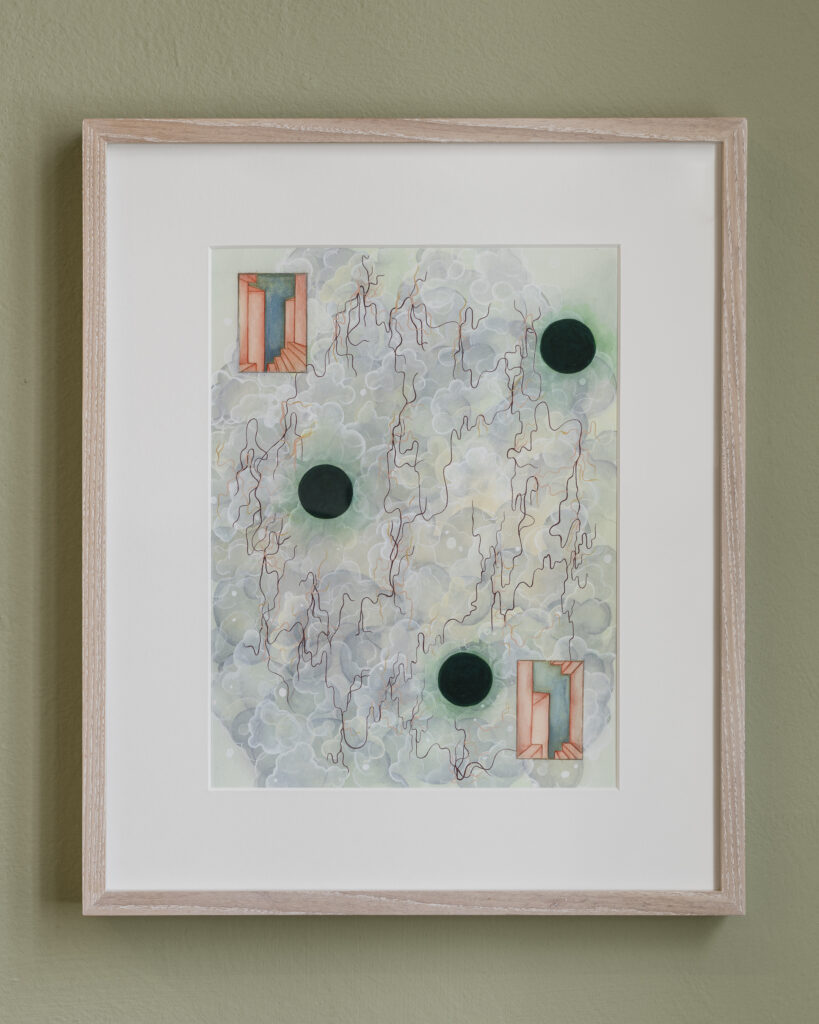 Tai ShaniThe Neon Hieroglyph: NH5, 2022
Tai ShaniThe Neon Hieroglyph: NH5, 2022
Glicée print o Somerset Velvet 330 gsm
30x40 cm
Courtesy: The Artist and Clima,Milan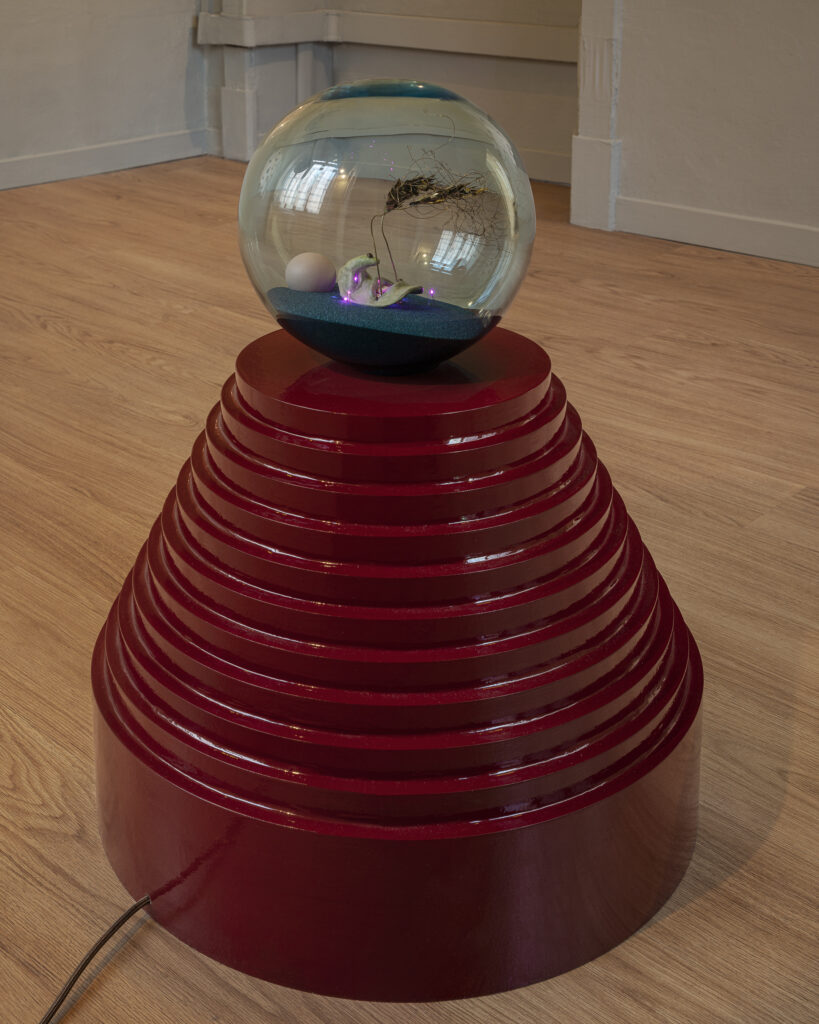 Tai ShaniTai Shani, NHA2, 2021
Tai ShaniTai Shani, NHA2, 2021
Wood, glass, brass, sand, epoxy, LED lights
d. 60x75 cm
Courtesy: The Artist and Clima,Milan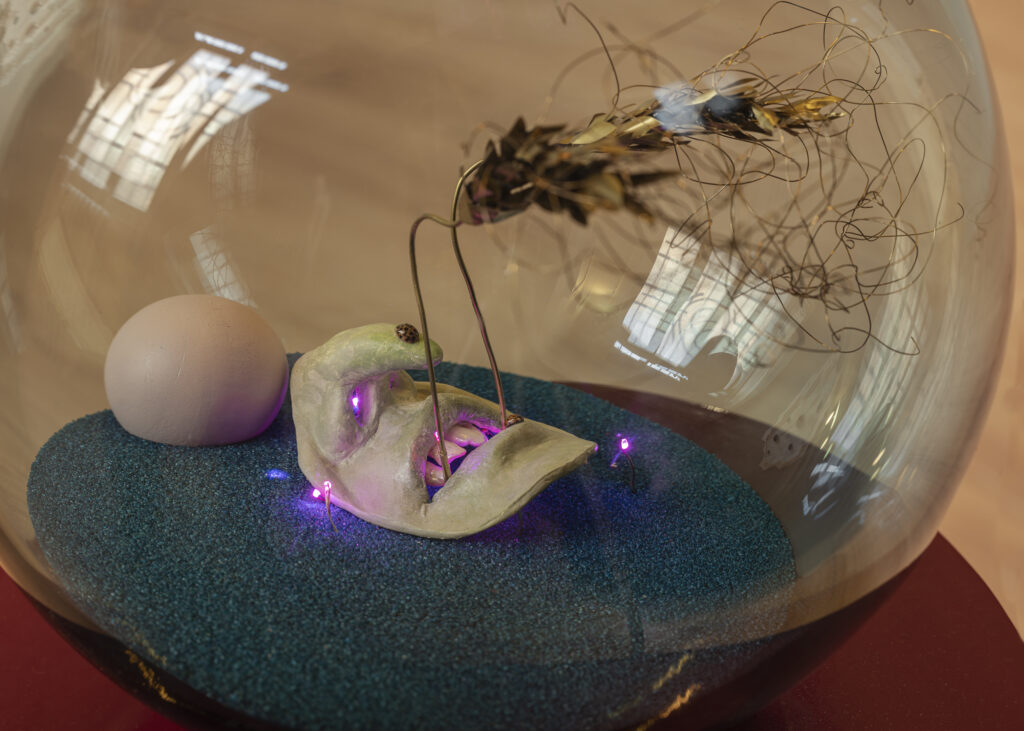 TLTS30Tai Shani, NHA2, 2021 (Detail)
TLTS30Tai Shani, NHA2, 2021 (Detail)
Wood, glass, brass, sand, epoxy, LED lights
d. 60x75 cm
Courtesy: The Artist and Clima,Milan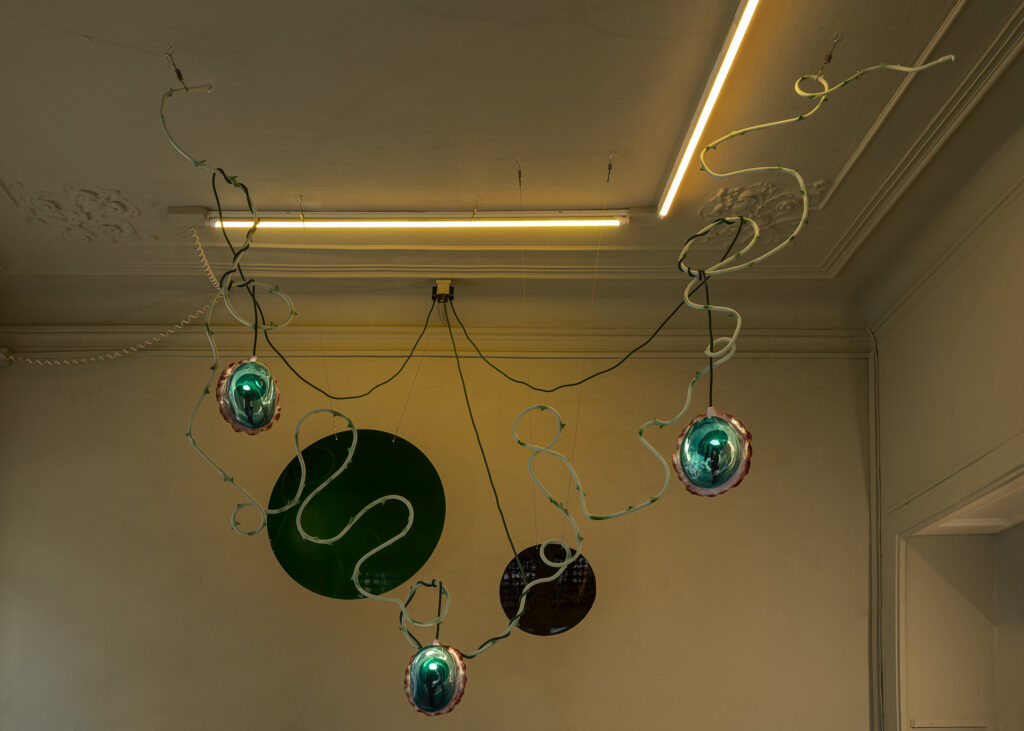 Tai ShaniNH: polymorph, dreaming android, flaming seraph, 2022
Tai ShaniNH: polymorph, dreaming android, flaming seraph, 2022
Iron vine, 3 glass eyes, 3 metal disks
variable dimensions
Courtesy: The Artist, Clima, Milan and Gathering,London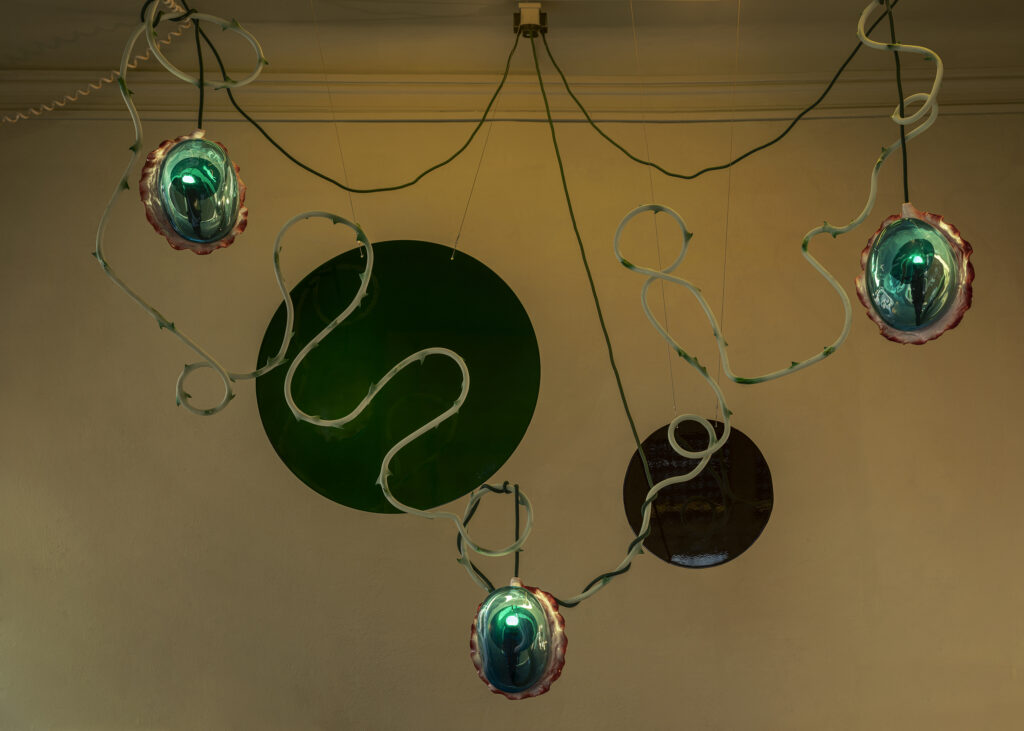 Tai ShaniNH: polymorph, dreaming android, flaming seraph, 2022
Tai ShaniNH: polymorph, dreaming android, flaming seraph, 2022
Iron vine, 3 glass eyes, 3 metal disks
variable dimensions
Courtesy: The Artist, Clima, Milan and Gathering,London
Tarek Lakhrissi (lives and works in Paris) is a French artist and poet with a background in literature who explores sociopolitical narratives and speculative situations of transformation and magic through text, film, installation, and performance. Lakhrissi has been exhibited internationally at galleries and institutions including Palais de Tokyo (Paris), Museum of Contemporary Art; 22nd Biennale of Sydney (Sydney), Wiels (Brussels), Frieze (UK), Centre Pompidou (Paris), Hayward Gallery (London), La Verrière, Fondation Hermès (BE), Haus der Kunst (Munich), Auto Italia South East (London), Grand Palais, FIAC (Paris), Fondation Lafayette Anticipations (Paris), Palazzo Re Rebaudengo/Sandretto (Guarene/Torino), Manchester International Festival (Manchester), Mostyn, (Llandudno), Tinguely Museum (Basel), HKW (Berlin), ICA (Londres), Shedhalle (Zurich); Fondation Ricard (Paris), Quadriennale di Roma; Palazzo delle Esposizioni (Roma), High Art (Paris), Kevin Space (Vienna), L’Espace Arlaud (Lausanne), Zabriskie (Geneva), Fondation Gulbenkian (Paris), Veda gallery (Firenze), CRAC Alsace (Altkirch), Kim? (Riga), Artexte (Montreal), Gaité Lyrique (Paris), SMC/CAC; (Vilnius). Lakhrissi’s artworks are part of different private and public collections like Defares, Sandretto Foundation or CNAP. He is represented by VITRINE Gallery (London/Basel) and Galerie Allen (Paris).
Tai Shani’s artistic practice, comprising performance, film, photography, and installation, uses experimental writing as a guiding method. Oscillating between theoretical concepts and visceral details, Shani’s texts attempt to create poetic coordinates in order to cultivate, by extending into divergent formats and collaborations, fragmentary cosmologies of nonsovereignty. Taking cues from both mournful and undead histories of marginalisation and solidarity, her work is invested in recovering feminised aesthetic modes – such as the floral, the trippy or the gothic – in a register of utopian militancy. Shani’s projects examine desire in its (infra-) structural dimension, exploring a realism that materially fantasises against the patriarchal racial capitalist present. In this vein, the epic, in both its literary long-form and excessive affect, shapes the framework of Shani’s artistic practice. Clusters of work like DC Productions or Neon Hieroglyph take mythical and historical narratives – such as Christine de Pizan’s allegorical city of women, or cases of psychedelic ergot poisoning causing social unrest – as a template and retell them, over time, through a range of practices, from watercolours and sculptures to animation in theatrical performance. Collected texts were published in Our Fatal Magic (2019) and The Neon Hieroglyph (2023). Tai Shani is the joint 2019 Turner Prize winner together with Lawrence Abu Hamdan, Helen Cammock and Oscar Murillo. Her work has been shown extensively in Britain and internationally.
